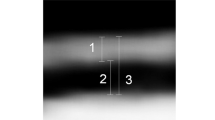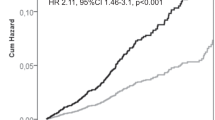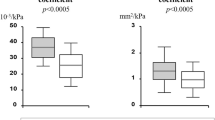Abstract
Catecholamines due to various mechanisms may contribute to the accumulation of collagen fibers and extracellular matrix in the arterial wall. The aim of this study was to compare intima-media thickness (IMT) of the common carotid artery (CCA) and carotid bifurcation (CB) in patients with pheochromocytoma, essential hypertension and healthy controls. Carotid ultrasound studies were carried out in 30 patients with pheochromocytoma matched for age and gender with 80 patients with essential hypertension and 40 normotensive controls. Significantly higher IMT was found in patients with pheochromocytoma and essential hypertension compared to controls when measured in the CCA (0.931±0.223, 0.825±0.146 and 0.738±0.113 mm; P<0.001; P<0.05), and only in patients with pheochromocytoma compared to controls in the region of CB (1.359±0.593, 1.095±0.311 and 0.968±0.247 mm; P<0.001; P=0.13). Higher IMT in patients with pheochromocytoma compared to patients with essential hypertension was also statistically significant in both carotid regions (both P<0.01). This difference remained significant after adjustment for all relevant clinical and biochemical covariates in the CCA (P=0.014) but disappeared in the region of CB (P=0.079). In summary, patients with pheochromocytoma have increased common carotid IMT when compared to patients with essential hypertension. This finding could be caused by the deleterious effects of the excess of catecholamines on the vascular wall growth and thickening.
This is a preview of subscription content, access via your institution
Access options
Subscribe to this journal
Receive 12 digital issues and online access to articles
$119.00 per year
only $9.92 per issue
Buy this article
- Purchase on Springer Link
- Instant access to full article PDF
Prices may be subject to local taxes which are calculated during checkout
Similar content being viewed by others
References
Zelinka T, Eisenhofer G, Pacák K . Pheochromocytoma as a catecholamine producing tumor: implications for clinical practice. Stress 2007; 10: 195–203.
Lenders JW, Eisenhofer G, Mannelli M, Pacak K . Phaeochromocytoma. Lancet 2005; 366: 665–675.
Widimskỳ Jr J . Recent advances in the diagnosis and treatment of pheochromocytoma. Kidney Blood Press Res 2006; 29: 321–326.
Manger WM . An overview of pheochromocytoma: history, current concepts, vagaries, and diagnostic challenges. Ann NY Acad Sci 2006; 1073: 1–20.
Zhang H, Faber JE . Trophic effect of norepinephrine on arterial intima-media and adventitia is augmented by injury and mediated by different alpha1-adrenoceptor subtypes. Circ Res 2001; 89: 815–822.
Johnson MD, Grignolo A, Kuhn CM, Schanberg SM . Hypertension and cardiovascular hypertrophy during chronic catecholamine infusion in rats. Life Sci 1983; 33: 169–180.
Nakaki T, Nakayama M, Yamamoto S, Kato R . Alpha 1-adrenergic stimulation and beta 2-adrenergic inhibition of DNA synthesis in vascular smooth muscle cells. Mol Pharmacol 1990; 37: 30–36.
Faber JE, Yang N, Xin X . Expression of alpha-adrenoceptor subtypes by smooth muscle cells and adventitial fibroblasts in rat aorta and in cell culture. J Pharmacol Exp Ther 2001; 298: 441–452.
Erami C, Zhang H, Ho JG, French DM, Faber JE . Alpha(1)-adrenoceptor stimulation directly induces growth of vascular wall in vivo. Am J Physiol Heart Circ Physiol 2002; 283: H1577–H1587.
O’Callaghan CJ, Williams B . The regulation of human vascular smooth muscle extracellular matrix protein production by alpha- and beta-adrenoceptor stimulation. J Hypertens 2002; 20: 287–294.
Porteri E, Rizzoni D, Mulvany MJ, De Ciuceis C, Sleiman I, Boari GE et al. Adrenergic mechanisms and remodeling of subcutaneous small resistance arteries in humans. J Hypertens 2003; 21: 2345–2352.
Rizzoni D, Muiesan ML, Porteri E, Salvetti M, Castellano M, Bettoni G et al. Relations between cardiac and vascular structure in patients with primary and secondary hypertension. J Am Coll Cardiol 1998; 32: 985–992.
Bernini G, Franzoni F, Galetta F, Moretti A, Taurino C, Bardini M et al. Carotid vascular remodeling in patients with pheochromocytoma. J Clin Endocrinol Metab 2006; 91: 1754–1760.
Mancia G, De Backer G, Dominiczak A, Cifkova R, Fagard R, Germano G et al. 2007 Guidelines for the Management of Arterial Hypertension: The Task Force for the Management of Arterial Hypertension of the European Society of Hypertension (ESH) and of the European Society of Cardiology (ESC). J Hypertens 2007; 25: 1105–1187.
Global Guideline for Type 2 Diabetes: recommendations for standard, comprehensive, minimal care. Diabet Med 2006; 23: 579–593.
Graham I, Atar D, Borch-Johnsen K, Boysen G, Burell G, Cifkova R et al. European guidelines on cardiovascular disease prevention in clinical practice: full text. Fourth Joint Task Force of the European Society of Cardiology and other societies on cardiovascular disease prevention in clinical practice (constituted by representatives of nine societies and by invited experts). Eur J Cardiovasc Prev Rehabil 2007; 14 (Suppl 2): S1–S113.
Devereux RB, Reichek N . Echocardiographic determination of left ventricular mass in man. Anatomic validation of the method. Circulation 1977; 55: 613–618.
Reichek N, Devereux RB . Reliable estimation of peak left ventricular systolic pressure by M-mode echographic-determined end-diastolic relative wall thickness: identification of severe valvular aortic stenosis in adult patients. Am Heart J 1982; 103: 202–203.
Devereux RB, Lutas EM, Casale PN, Kligfield P, Eisenberg RR, Hammond IW et al. Standardization of M-mode echocardiographic left ventricular anatomic measurements. J Am Coll Cardiol 1984; 4: 1222–1230.
Holaj R, Zelinka T, Wichterle D, Petrák O, Strauch B, Widimsky Jr J . Increased intima-media thickness of the common carotid artery in primary aldosteronism in comparison with essential hypertension. J Hypertens 2007; 25: 1451–1457.
Pignoli P, Tremoli E, Poli A, Oreste P, Paoletti R . Intimal plus medial thickness of the arterial wall: a direct measurement with ultrasound imaging. Circulation 1986; 74: 1399–1406.
Fisher SA, Absher M . Norepinephrine and ANG II stimulate secretion of TGF-beta by neonatal rat cardiac fibroblasts in vitro. Am J Physiol 1995; 268: C910–C917.
Zelinka T, Petrák O, Strauch B, Holaj R, Kvasnička J, Mazoch J et al. Elevated inflammation markers in pheochromocytoma compared to other forms of hypertension. Neuroimmunomodulation 2007; 14: 57–64.
Wang TJ, Nam BH, Wilson PW, Wolf PA, Levy D, Polak JF et al. Association of C-reactive protein with carotid atherosclerosis in men and women: the Framingham Heart Study. Arterioscler Thromb Vasc Biol 2002; 22: 1662–1667.
Magyar MT, Szikszai Z, Balla J, Valikovics A, Kappelmayer J, Imre S et al. Early-onset carotid atherosclerosis is associated with increased intima-media thickness and elevated serum levels of inflammatory markers. Stroke 2003; 34: 58–63.
Makita S, Nakamura M, Hiramori K . The association of C-reactive protein levels with carotid intima-media complex thickness and plaque formation in the general population. Stroke 2005; 36: 2138–2142.
Zelinka T, Strauch B, Petrák O, Holaj R, Vránková A, Weisserová H et al. Increased blood pressure variability in pheochromocytoma compared to essential hypertension patients. J Hypertens 2005; 23: 2033–2039.
Sander D, Kukla C, Klingelhofer J, Winbeck K, Conrad B . Relationship between circadian blood pressure patterns and progression of early carotid atherosclerosis: a 3-year follow-up study. Circulation 2000; 102: 1536–1541.
Shub C, Cueto-Garcia L, Sheps SG, Ilstrup DM, Tajik AJ . Echocardiographic findings in pheochromocytoma. Am J Cardiol 1986; 57: 971–975.
Amar L, Servais A, Gimenez-Roqueplo AP, Zinzindohoue F, Chatellier G, Plouin PF . Year of diagnosis, features at presentation, and risk of recurrence in patients with pheochromocytoma or secreting paraganglioma. J Clin Endocrinol Metab 2005; 90: 2110–2116.
Pacak K, Ilias I, Adams KT, Eisenhofer G . Biochemical diagnosis, localization and management of pheochromocytoma: focus on multiple endocrine neoplasia type 2 in relation to other hereditary syndromes and sporadic forms of the tumour. J Intern Med 2005; 257: 60–68.
Bots ML, Evans GW, Riley WA, Grobbee DE . Carotid intima-media thickness measurements in intervention studies: design options, progression rates, and sample size considerations: a point of view. Stroke 2003; 34: 2985–2994.
Meijer R, Grobee DE, Bots ML . Mannheim consensus on carotid intima-media thickness: opposite and complementary points of view. Cerebrovasc Dis 2006; 21: 415–416.
Wikstrand J . Methodological considerations of ultrasound measurement of carotid artery intima-media thickness and lumen diameter. Clin Physiol Funct Imaging 2007; 27: 341–345.
Touboul PJ, Hennerici MG, Meairs S, Adams H, Amarenco P, Bornstein N et al. Mannheim carotid intima-media thickness consensus (2004–2006). An update on behalf of the Advisory Board of the 3rd and 4th Watching the Risk Symposium, 13th and 15th European Stroke Conferences, Mannheim, Germany, 2004, and Brussels, Belgium, 2006. Cerebrovasc Dis 2007; 23: 75–80.
Borhani NO, Mercuri M, Borhani PA, Buckalew VM, Canossa-Terris M, Carr AA et al. Final outcome results of the Multicenter Isradipine Diuretic Atherosclerosis Study (MIDAS). A randomized controlled trial. JAMA 1996; 276: 785–791.
Zanchetti A, Rosei EA, Dal Palu C, Leonetti G, Magnani B, Pessina A . The Verapamil in Hypertension and Atherosclerosis Study (VHAS): results of long-term randomized treatment with either verapamil or chlorthalidone on carotid intima-media thickness. J Hypertens 1998; 16: 1667–1676.
Simon A, Gariepy J, Moyse D, Levenson J . Differential effects of nifedipine and co-amilozide on the progression of early carotid wall changes. Circulation 2001; 103: 2949–2954.
Zanchetti A, Bond MG, Hennig M, Neiss A, Mancia G, Dal Palu C et al. Calcium antagonist lacidipine slows down progression of asymptomatic carotid atherosclerosis: principal results of the European Lacidipine Study on Atherosclerosis (ELSA), a randomized, double-blind, long-term trial. Circulation 2002; 106: 2422–2427.
Acknowledgements
This study was supported by the Research Projects 0021620807, 0021620808 from the Ministry of Education of the Czech Republic and by the Grant NR/8155-5 from the Ministry of Health of the Czech Republic. We are grateful to Rudy Meijer, University Medical Center Utrecht, The Netherlands, for providing Meijer's Carotid Arc and Dr Jiri Frohlich, University of British Columbia, Vancouver BC, Canada, for reviewing of the paper.
Author information
Authors and Affiliations
Corresponding author
Additional information
Conflict of interest
None.
Rights and permissions
About this article
Cite this article
Holaj, R., Zelinka, T., Wichterle, D. et al. Increased carotid intima-media thickness in patients with pheochromocytoma in comparison to essential hypertension. J Hum Hypertens 23, 350–358 (2009). https://doi.org/10.1038/jhh.2008.130
Received:
Revised:
Accepted:
Published:
Issue Date:
DOI: https://doi.org/10.1038/jhh.2008.130
Keywords
This article is cited by
-
Coexistence of osteoporosis and atherosclerosis in pheochromocytoma: new insights into its long-term management
Osteoporosis International (2020)
-
Factors influencing arterial stiffness in pheochromocytoma and effect of adrenalectomy
Hypertension Research (2010)



